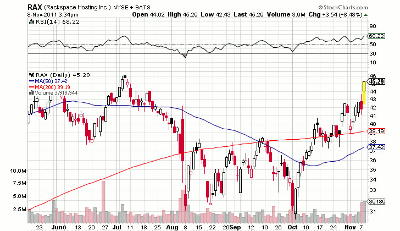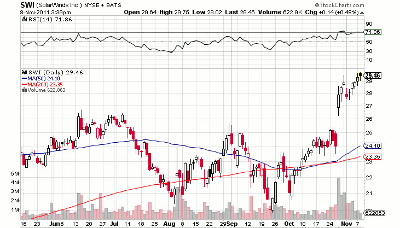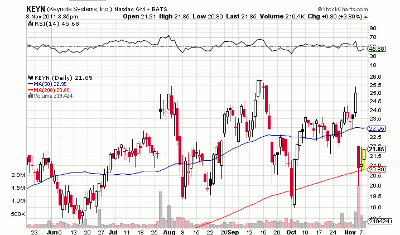Rackspace Hosting vaulted Tuesday after its earnings report, as demand grows for cloud-based business applications. MoneyShow.com contributor Kate Stalter looks at some fundamental and technical indicators for Rackspace and two other stocks in the cloud computing space.
Web hosting specialist Rackspace (RAX) jumped more than 8% intraday Tuesday after a better-than-expected third-quarter report late Monday. The company said results were boosted by increased migration to the cloud and away from applications downloaded onto individual workstations.
Even before the report, Rackspace had been shaping a constructive price consolidation. The stock rallied to an all-time high of $46.50 in late April, as the broader market also peaked.
Rackspace attempted a rally in early July—again, in tandem with the major indices. The wider market rally attempt fizzled, and Rackspace fell back into its consolidation.
The low of the current correction was $30.34, reached on October 4, the same day the indices also bottomed out and reversed higher.
Rackspace’s current base is potentially bullish, because that October 4 low undercut the low of the prior consolidation. That type of price action often precedes a fresh run-up, as investors lacking conviction are flushed out, and bargain hunters who see potential in the stock grab shares at low prices.
As of Tuesday, the stock has notched gains in five of the past six weeks. That’s a good sign, although it would be even better to see higher levels of trading volume.
The company has a couple other factors in its favor. It’s a fairly recent IPO, having made its NYSE debut in August 2008. Stocks that are within a few years of their IPOs are often among the market’s best price gainers.
Rackspace also boasts solid fundamentals. Earnings grew between 17% and 63% in the past eight quarters. Sales growth has been gradually trending higher, from a rate of 18% in the quarter ended December 2009, to 32% growth most recently.
I’m bullish on Rackspace’s prospects, and I see the stock as being in a technical buy range at the moment. However, don’t be surprised if it pulls back after the post-earnings leap, as traders and investors who bought in at lower prices pocket some profits.
When the next pullback occurs, watch for support at key moving averages. Of course, the most bullish technical sign would be a continuation of the heavy-volume march toward a new price high.
|pagebreak|Industry peer SolarWinds (SWI)—another fairly new entrant to the public markets, having IPOed in May 2009—is also sporting a good chart. It’s been running to fresh all-time highs in each of the past three weeks, and remains out of buy range at the moment.
While Rackspace specializes in managed hosting and cloud services, SolarWinds has a somewhat different focus. The company provides software tools for small businesses to help with network management, virtualization, data storage, and other needs.
It’s another example of a young company that’s amassed a solid track record when it comes to growth. Yearly profits have risen in the past four years, and 2011 is expected to wrap up with income of 99 cents per share, up 29% from last year. Quarterly earnings and revenue have been increasing at the kind of rates I look for in the best growth stocks—that is, 25% or higher in recent quarters.
So why keep monitoring a stock whose price is extended well beyond a reasonable buy point? It’s essentially the same idea discussed above: An orderly pullback to a key moving average, say the 20-day or even 50-day, could offer a new entry opportunity.
Recent volume trends bode well for the stock’s future price growth. Upside trade has been enormous in the past two weeks, following a gap-up of nearly 16% on October 27, following a better-than-expected third-quarter earnings report.
Huge buying is a sign that institutional investors, such as hedge funds, pension funds, and mutual funds, are piling into a stock. Because professional investors can take days, weeks or even months to accumulate a full position in a stock, huge buying after an earnings report can be a sign of more purchases to follow. It’s a very clear signal that the professionals have confidence in the stock, and believe it has good potential to rise even further.
However, don’t chase a stock after this type of price increase. Wait for a pullback to offer your next chance.
|pagebreak|A good fundamental performer from the network services space, but one whose chart has been all over the place, is Keynote Systems (KEYN). The company provides monitoring and data-management services for mobile networks and smartphone apps. It boasts corporate clients from a range of industries, including financial services, hospitality, and retail.
This is a very small company, with a market cap of just $364 million. It trades about 220,000 shares a day, somewhat on the thin side. That level of turnover suggests that trade could at times be erratic—and that’s been the case. The stock has a high beta, 1.38, an indication that it is more volatile than the benchmark index.
The stock gapped 16% lower last Friday after the company’s fourth-quarter earnings report, which showed a big gain on an accounting move. Ex-items, the company missed Wall Street views.
It’s been getting support at its 200-day average, but the stock has a lot of work to do before becoming technically sound once again. Wall Street now sees 2012 earnings dropping 3%, to $1.15 per share.
Though Keynote has shown a year-to-date gain of nearly 50%, it needs more time to prove itself technically before it becomes a buy candidate.
At the time of publication, Kate Stalter did not own positions in any of the stocks mentioned in this article.
Related Reading:
























